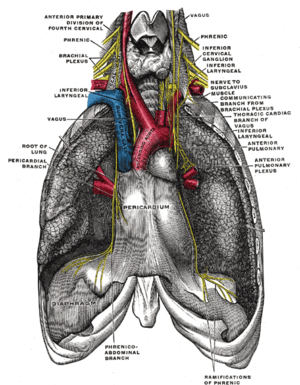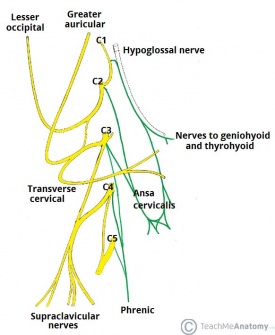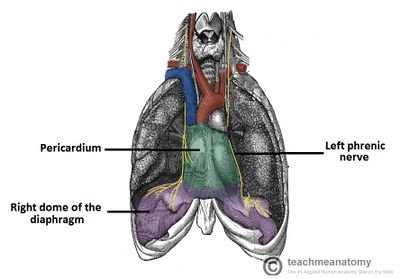Phrenic Nerve: Difference between revisions
No edit summary |
No edit summary |
||
| Line 1: | Line 1: | ||
==Phrenic Nerve== | ==Phrenic Nerve== | ||
[[File:Phrenic nerve.png|right|frameless]] | [[File:Phrenic nerve.png|right|frameless]] | ||
The phrenic nerve is among the most important nerves in the body due to its role in respiration. The phrenic nerve provides the primary motor supply to the diaphragm, the major respiratory muscle<ref>Mandoorah S, Mead T. [https://www.ncbi.nlm.nih.gov/books/NBK482227/ Phrenic nerve injury.]2018 Available from: https://www.ncbi.nlm.nih.gov/books/NBK482227/<nowiki/>(accessed 8.2.2021)</ref>. It passes motor information to the diaphragm and receives sensory information from it. There are two phrenic nerves, a left and a right one.<ref name=":0">Prakash; Prabhu, L. V.; Madhyastha, S; Singh, G (2007). [http://smj.sma.org.sg/4812/4812cr10.pdf "A variation of the phrenic nerve: Case report and review"]</ref> | The phrenic nerve is among the most important nerves in the body due to its role in respiration. The phrenic nerve provides the primary motor supply to the diaphragm, the major respiratory muscle<ref name=":1">Mandoorah S, Mead T. [https://www.ncbi.nlm.nih.gov/books/NBK482227/ Phrenic nerve injury.]2018 Available from: https://www.ncbi.nlm.nih.gov/books/NBK482227/<nowiki/>(accessed 8.2.2021)</ref>. It passes motor information to the diaphragm and receives sensory information from it. There are two phrenic nerves, a left and a right one.<ref name=":0">Prakash; Prabhu, L. V.; Madhyastha, S; Singh, G (2007). [http://smj.sma.org.sg/4812/4812cr10.pdf "A variation of the phrenic nerve: Case report and review"]</ref> | ||
Image 1: The Phrenic nerve, showing | Image 1: The Phrenic nerve, showing course to diaphragm. | ||
Both of these nerves supply | |||
Both of these nerves supply | * Motor fibers to the diaphragm and | ||
* Sensory fibers to the fibrous pericardium, mediastinal pleura, and diaphragmatic peritoneum.<ref name=":0" /> | |||
==Origin== | |||
[[File:Major-Branches-of-the-Cervical-Plexus.jpg|thumb|336x336px|Image 1 showing origin of the Phrenic Nerve]] | [[File:Major-Branches-of-the-Cervical-Plexus.jpg|thumb|336x336px|Image 1 showing origin of the Phrenic Nerve]] | ||
The phrenic nerve originates mainly from the 4th cervical nerve, but also receives contributions from the 3rd and 5th cervical nerves (C3-C5) in humans.<ref>Moore, Keith L. (1999). ''Clinically oriented anatomy''. Philadelphia: Lippincott Williams & Wilkins. ISBN 978-0-683-06141-3 | The phrenic nerve originates mainly from the 4th cervical nerve, but also receives contributions from the 3rd and 5th cervical nerves (C3-C5) in humans.<ref>Moore, Keith L. (1999). ''Clinically oriented anatomy''. Philadelphia: Lippincott Williams & Wilkins. ISBN 978-0-683-06141-3 | ||
</ref> Thus, the phrenic nerve receives innervation from parts of both the cervical plexus and the brachial plexus of nerves. | </ref> Thus, the phrenic nerve receives innervation from parts of both the cervical plexus and the brachial plexus of nerves. | ||
==Course== | |||
In the neck, the phrenic nerve lies on the anterior surface of the anterior scalene muscle, passes over the dome of the pleura and enters the thorax posterior to the subclavian vein. The right and left phrenic nerves have a different course in the thorax but as a general rule they descend as lateral as possible whilst keeping in contact with the mediastinal pleura. Both travel anterior to the hilum/bronchus on their respective side.<ref name=":2">Radiopedia [https://radiopaedia.org/articles/phrenic-nerve Phrenic nerve] Available from: https://radiopaedia.org/articles/phrenic-nerve (last accessed 8.2.2021)</ref> | |||
The '''''right Phrenic nerve''''' descends in the thorax along the right side of the right brachiocephalic vein and the superior vena cava. It passes in front of the root of the right lung and runs along the right side of the pericardium, which separates the nerve from the right atrium. It then descends on the right side of the inferior vena cava to the diaphragm.Its terminal branches pass through the caval opening in the diaphragm to supply the central part of the peritoneum on its under aspect. (Image 2) | The '''''right Phrenic nerve''''' descends in the thorax along the right side of the right brachiocephalic vein and the superior vena cava. It passes in front of the root of the right lung and runs along the right side of the pericardium, which separates the nerve from the right atrium. It then descends on the right side of the inferior vena cava to the diaphragm.Its terminal branches pass through the caval opening in the diaphragm to supply the central part of the peritoneum on its under aspect. (Image 2) | ||
[[File:Phrenic-Nerve-Motor-Innervation-to-the-Diaphragm.jpg|thumb| | [[File:Phrenic-Nerve-Motor-Innervation-to-the-Diaphragm.jpg|thumb|400x400px|Image 2 showing Right and Left Phrenic nerve supplying ipsilateral dome of the diaphragm]] | ||
The '''''left Phrenic nerve''''' descends in the thorax along the left side of the left subclavian artery. It crosses the left side of the aortic arch and here crosses the left side of the left Vagus nerve. It passes in front of the root of the left lung and then descends over the left surface of the pericardium which separates the nerve from the left ventricle. On reaching the diaphragm, the terminal branches pierce the muscle and supply the central part of the peritoneum on its under aspect.(Image 2)<ref name=":0" /> | The '''''left Phrenic nerve''''' descends in the thorax along the left side of the left subclavian artery. It crosses the left side of the aortic arch and here crosses the left side of the left Vagus nerve. It passes in front of the root of the left lung and then descends over the left surface of the pericardium which separates the nerve from the left ventricle. On reaching the diaphragm, the terminal branches pierce the muscle and supply the central part of the peritoneum on its under aspect.(Image 2)<ref name=":0" /> | ||
The | == Supply == | ||
The phrenic nerve is the sole motor supply to each hemidiaphragm. It also provides sensory supply to: | |||
* diaphragm (except the most peripheral diaphragm, which is supplied by intercostal nerves) | |||
* mediastinal pleura | |||
* pericardium | |||
* central parts of diaphragmatic pleura and peritoneum<ref name=":2" /> | |||
==== | == Phrenic Nerve Palsy == | ||
Phrenic nerve palsy (also known as phrenic nerve paresis or paralysis) has many causes and can be caused by lesions anywhere along the course of the phrenic nerve, as it travels from the neck, to pierce the diaphragm adjacent to the pericardium. | |||
* One common etiology of phrenic nerve injury is from surgery, primarily thoracic and cardiac surgery. The left phrenic nerve descends anteriorly between the pericardium and mediastinal pleura and can be injured while dissecting near the area of an internal thoracic artery. | |||
* The phrenic nerve can also be damaged from blunt or penetrating trauma, metabolic diseases eg diabetes, infectious causes eg Lyme disease and herpes zoster, direct invasion by tumor, neurological diseases such eg cervical spondylosis and multiple sclerosis, myopathy and immunological disease (e.g., Guillain-Barre syndrome)<ref name=":1" />. | |||
* Spinal cord injury is another cause. Depending on which vertebrae are damaged, nerve impulses can be disrupted. It is more likely if the injury occurs above the third vertebrae. If the injury is lower in the spine, breathing is usually not impacted. | |||
The diagnosis of phrenic nerve injury requires high suspicion due to nonspecific signs and symptoms including unexplained shortness of breath, recurrent pneumonia, anxiety, insomnia, morning headache, excessive daytime somnolence, orthopnea, fatigue, and difficulty weaning from mechanical ventilation. | |||
On physical examinations, findings may include decreased breath sounds on the affected side, dullness to percussion of the affected side of the chest and inward movement of the epigastrium during inspiration. | |||
{| width="100%" cellspacing="1" cellpadding="1" | {| width="100%" cellspacing="1" cellpadding="1" | ||
|- | |- | ||
Revision as of 07:54, 8 February 2021
Phrenic Nerve[edit | edit source]
The phrenic nerve is among the most important nerves in the body due to its role in respiration. The phrenic nerve provides the primary motor supply to the diaphragm, the major respiratory muscle[1]. It passes motor information to the diaphragm and receives sensory information from it. There are two phrenic nerves, a left and a right one.[2]
Image 1: The Phrenic nerve, showing course to diaphragm.
Both of these nerves supply
- Motor fibers to the diaphragm and
- Sensory fibers to the fibrous pericardium, mediastinal pleura, and diaphragmatic peritoneum.[2]
Origin[edit | edit source]
The phrenic nerve originates mainly from the 4th cervical nerve, but also receives contributions from the 3rd and 5th cervical nerves (C3-C5) in humans.[3] Thus, the phrenic nerve receives innervation from parts of both the cervical plexus and the brachial plexus of nerves.
Course[edit | edit source]
In the neck, the phrenic nerve lies on the anterior surface of the anterior scalene muscle, passes over the dome of the pleura and enters the thorax posterior to the subclavian vein. The right and left phrenic nerves have a different course in the thorax but as a general rule they descend as lateral as possible whilst keeping in contact with the mediastinal pleura. Both travel anterior to the hilum/bronchus on their respective side.[4]
The right Phrenic nerve descends in the thorax along the right side of the right brachiocephalic vein and the superior vena cava. It passes in front of the root of the right lung and runs along the right side of the pericardium, which separates the nerve from the right atrium. It then descends on the right side of the inferior vena cava to the diaphragm.Its terminal branches pass through the caval opening in the diaphragm to supply the central part of the peritoneum on its under aspect. (Image 2)
The left Phrenic nerve descends in the thorax along the left side of the left subclavian artery. It crosses the left side of the aortic arch and here crosses the left side of the left Vagus nerve. It passes in front of the root of the left lung and then descends over the left surface of the pericardium which separates the nerve from the left ventricle. On reaching the diaphragm, the terminal branches pierce the muscle and supply the central part of the peritoneum on its under aspect.(Image 2)[2]
Supply[edit | edit source]
The phrenic nerve is the sole motor supply to each hemidiaphragm. It also provides sensory supply to:
- diaphragm (except the most peripheral diaphragm, which is supplied by intercostal nerves)
- mediastinal pleura
- pericardium
- central parts of diaphragmatic pleura and peritoneum[4]
Phrenic Nerve Palsy[edit | edit source]
Phrenic nerve palsy (also known as phrenic nerve paresis or paralysis) has many causes and can be caused by lesions anywhere along the course of the phrenic nerve, as it travels from the neck, to pierce the diaphragm adjacent to the pericardium.
- One common etiology of phrenic nerve injury is from surgery, primarily thoracic and cardiac surgery. The left phrenic nerve descends anteriorly between the pericardium and mediastinal pleura and can be injured while dissecting near the area of an internal thoracic artery.
- The phrenic nerve can also be damaged from blunt or penetrating trauma, metabolic diseases eg diabetes, infectious causes eg Lyme disease and herpes zoster, direct invasion by tumor, neurological diseases such eg cervical spondylosis and multiple sclerosis, myopathy and immunological disease (e.g., Guillain-Barre syndrome)[1].
- Spinal cord injury is another cause. Depending on which vertebrae are damaged, nerve impulses can be disrupted. It is more likely if the injury occurs above the third vertebrae. If the injury is lower in the spine, breathing is usually not impacted.
The diagnosis of phrenic nerve injury requires high suspicion due to nonspecific signs and symptoms including unexplained shortness of breath, recurrent pneumonia, anxiety, insomnia, morning headache, excessive daytime somnolence, orthopnea, fatigue, and difficulty weaning from mechanical ventilation.
On physical examinations, findings may include decreased breath sounds on the affected side, dullness to percussion of the affected side of the chest and inward movement of the epigastrium during inspiration.
References[edit | edit source]
- ↑ 1.0 1.1 Mandoorah S, Mead T. Phrenic nerve injury.2018 Available from: https://www.ncbi.nlm.nih.gov/books/NBK482227/(accessed 8.2.2021)
- ↑ 2.0 2.1 2.2 Prakash; Prabhu, L. V.; Madhyastha, S; Singh, G (2007). "A variation of the phrenic nerve: Case report and review"
- ↑ Moore, Keith L. (1999). Clinically oriented anatomy. Philadelphia: Lippincott Williams & Wilkins. ISBN 978-0-683-06141-3
- ↑ 4.0 4.1 Radiopedia Phrenic nerve Available from: https://radiopaedia.org/articles/phrenic-nerve (last accessed 8.2.2021)









